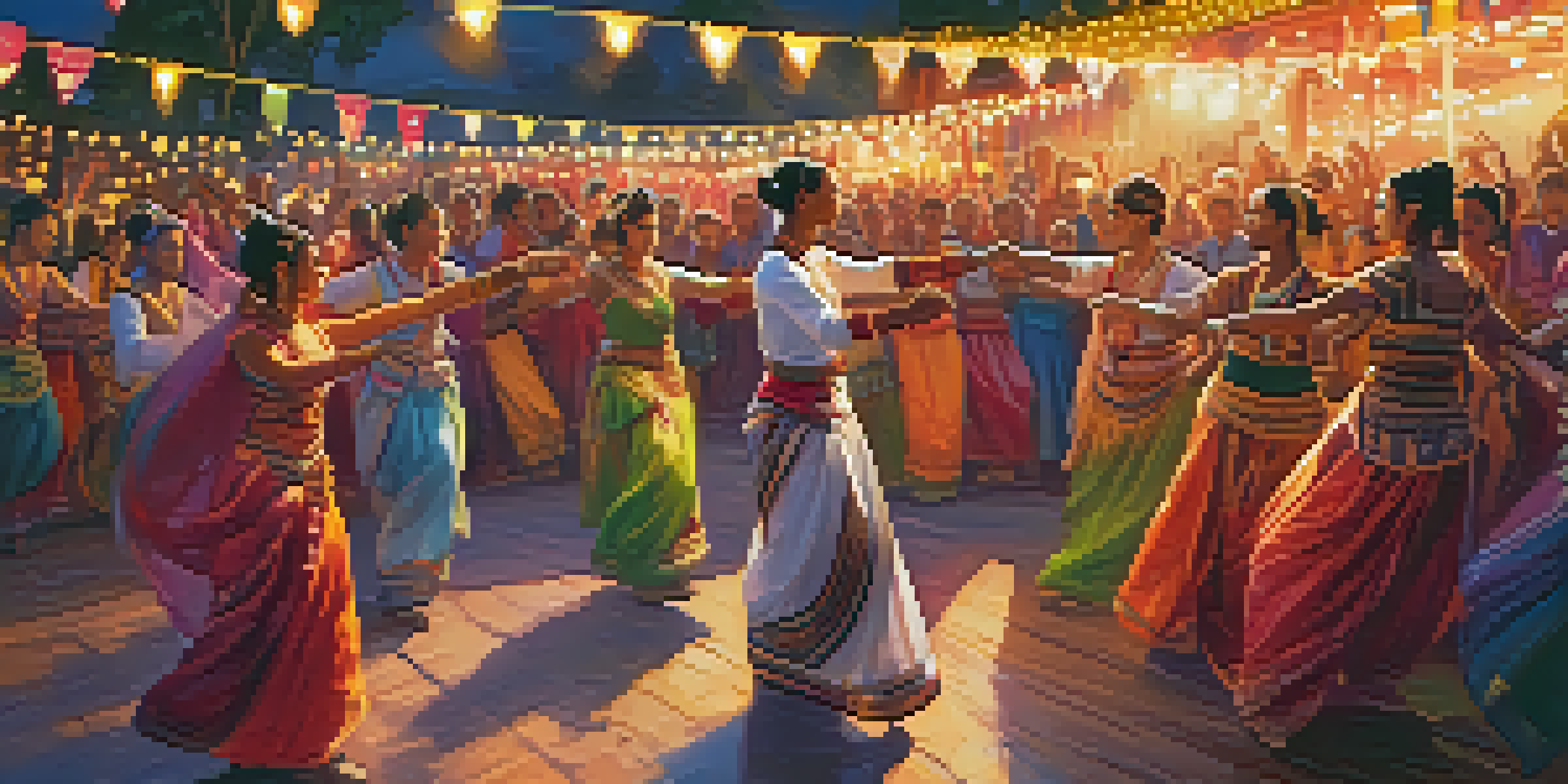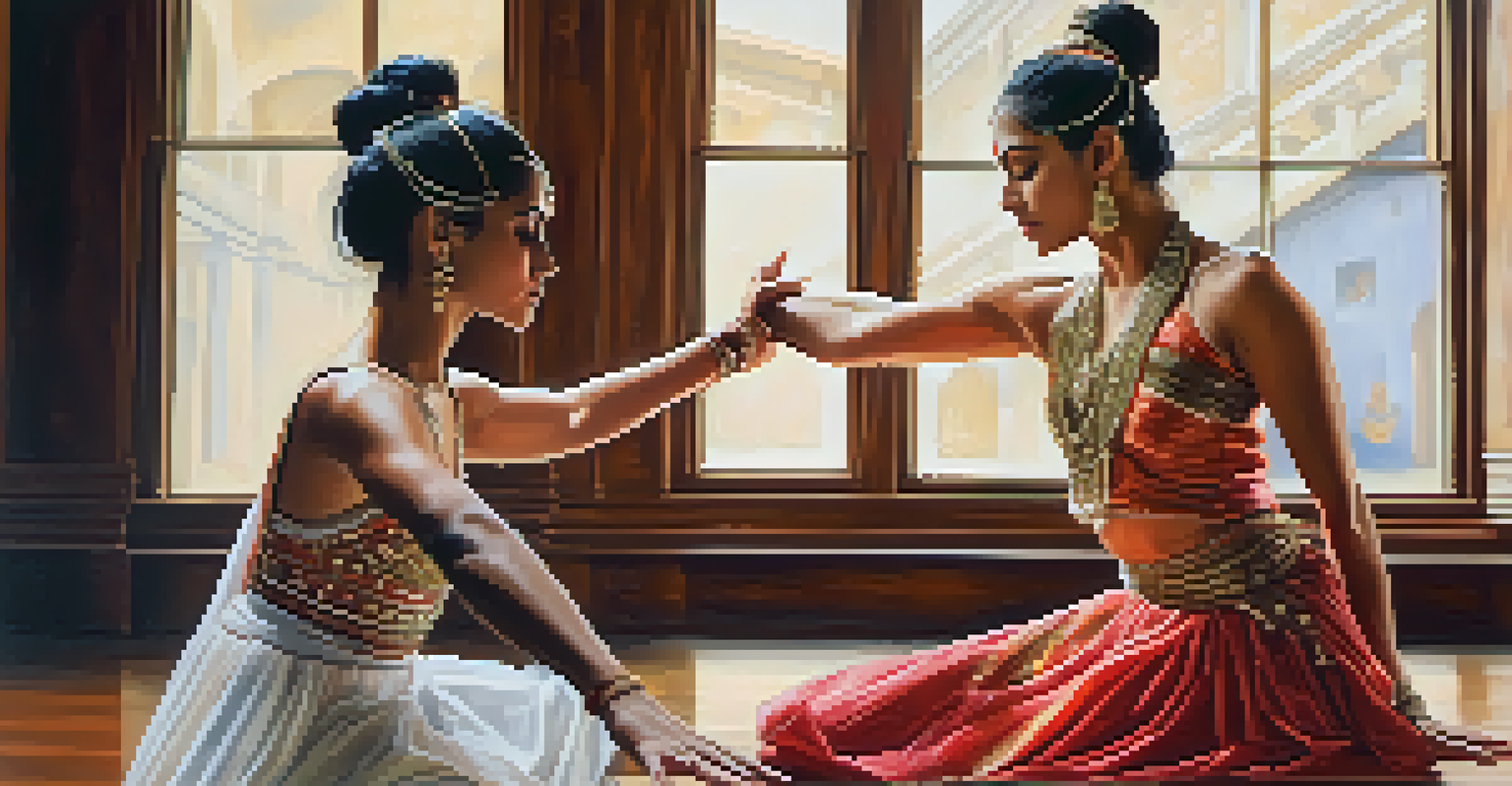The Evolution of Dance Styles Through Global Collaborations

The Roots of Dance: Cultural Influences and Traditions
Dance has always been a reflection of culture, embodying the values and stories of communities. From traditional folk dances like the Irish jig to the vibrant movements of African tribal dances, each style encapsulates its origins. These dances often serve as communal expressions, passed down through generations and adapted over time to incorporate new cultural elements.
Dance is the hidden language of the soul.
As globalization increased, so did the blending of these traditional dance forms. For instance, the fusion of African rhythms with European ballet resulted in innovative performances that highlight the beauty of both traditions. This evolution not only preserves cultural heritage but also enriches the global dance landscape, allowing for a wider appreciation of diverse styles.
Consequently, the way we view dance has transformed. Instead of being confined to regional borders, dance now acts as a universal language that connects people across the globe. This intermingling of styles fosters creativity and inspires new generations of dancers to experiment and innovate.
Globalization and the Spread of Dance Styles
With the rise of digital communication, dance has become more accessible than ever. Platforms like YouTube and TikTok enable dancers to share their moves with a worldwide audience, promoting the rapid spread of various styles. This accessibility encourages collaboration, as dancers from different backgrounds can learn from one another and create unique hybrids of dance.

For example, K-pop has taken the world by storm, blending styles like hip-hop, jazz, and traditional Korean dance. This genre exemplifies how global collaboration can produce a fresh, energetic style that resonates with audiences worldwide. The popularity of K-pop has not only influenced music but also dance trends, encouraging fans to adopt and adapt the choreography in their own performances.
Dance Reflects Cultural Diversity
Dance serves as a universal language that embodies the values and stories of various cultures, evolving through globalization and collaboration.
As a result, we see an exciting evolution in dance where traditional techniques are infused with contemporary flair. This blend creates a dynamic scene in which dancers continually push the boundaries of their art, making dance a living, breathing entity that evolves with society.
The Role of Technology in Dance Evolution
Technology plays a pivotal role in the evolution of dance styles, facilitating collaboration across distances. Video conferencing tools allow dancers worldwide to connect and share their expertise, leading to innovative choreographies that merge various techniques. This technological integration not only preserves traditional forms but also modernizes them, making them relevant for today’s audiences.
To watch us dance is to hear our hearts speak.
Moreover, dance software and apps enable choreographers to experiment with movement and visualize their ideas before ever stepping foot in a studio. For instance, programs like Dance Designer allow users to create and manipulate dance sequences digitally, leading to groundbreaking performances that might have been impossible otherwise. This tech-driven approach inspires creativity and pushes the boundaries of traditional dance.
Ultimately, technology serves as a bridge that connects different dance communities, fostering collaboration while enhancing the creative process. As dancers continue to embrace these advancements, we can expect to see even more exciting hybrids emerge, enriching our understanding of global dance.
Collaborative Dance Projects: Celebrating Diversity
Collaborative dance projects highlight the beauty of diversity, showcasing how different styles can come together to create something truly unique. Events like the International Dance Festival bring together artists from various backgrounds to share their skills and perspectives. These collaborations often result in performances that celebrate cultural diversity, demonstrating how dance can serve as a unifying force.
One notable example is the collaboration between Indian classical dancers and contemporary ballet performers. This partnership not only showcases the technical prowess of each dancer but also highlights the emotional storytelling inherent in both styles. Audiences are treated to a rich tapestry of movement that transcends cultural boundaries, fostering greater appreciation for each form.
Technology Fuels Dance Innovation
Advancements in technology, such as video conferencing and dance software, enhance collaboration and creativity, leading to innovative choreographies.
Such joint ventures remind us that dance is not just about individual expression; it's about sharing experiences and narratives. By embracing diversity in dance, we open doors to new creative possibilities, encouraging future generations to explore and honor their cultural roots while innovating.
Dance Festivals: A Hub for Global Collaboration
Dance festivals serve as melting pots of creativity, where artists from around the world converge to celebrate their craft. These events often feature workshops, performances, and competitions that encourage collaboration and knowledge-sharing among participants. Through these immersive experiences, dancers can learn new techniques and challenge themselves creatively, which ultimately enriches their individual styles.
For instance, the Edinburgh Festival Fringe draws performers from diverse backgrounds, offering a platform for unique collaborations that push creative boundaries. Dancers often find inspiration through interactions with artists from different cultures, resulting in fresh interpretations of traditional dances. This cross-pollination of ideas fuels innovation and fosters a sense of community within the global dance scene.
Moreover, these festivals can spark lasting partnerships, as artists continue to collaborate long after the event is over. By participating in these gatherings, dancers not only enhance their skills but also contribute to the ongoing evolution of dance, ensuring that it remains a vibrant and relevant art form.
Social Media: A Catalyst for Dance Trends
Social media has become a powerful catalyst for the evolution of dance styles, creating a platform for trends to emerge rapidly. Dancers utilize platforms like Instagram and TikTok to showcase their talents, often leading to viral dance challenges that capture the public's imagination. This instant exposure allows various dance forms to gain popularity, leading to unexpected collaborations and innovations.
Take the viral success of the 'Renegade' dance, for example. Originally created by a young dancer, it gained widespread attention when celebrities began sharing their versions. This phenomenon illustrates how a single dance can transcend cultural boundaries and inspire countless interpretations, all while fostering a sense of community among dancers and fans alike.
Festivals Promote Global Collaboration
Dance festivals create a vibrant environment for artists from different backgrounds to share techniques and collaborate, enriching the global dance community.
As trends ebb and flow, they often lead to new styles or revivals of older ones, showcasing the dynamic nature of dance. By leveraging social media, dancers can experiment with different movements and styles, encouraging a culture of creativity that continuously shapes the dance landscape.
Future of Dance: Embracing Global Collaborations
As we look to the future, the evolution of dance styles through global collaborations shows no signs of slowing down. With ongoing advancements in technology and communication, we can expect even more innovative fusions of styles that reflect our increasingly interconnected world. The future of dance promises to embrace diversity, celebrating the rich tapestry of cultures that contribute to this art form.
Moreover, as more dancers recognize the importance of collaboration, we will likely see an emphasis on inclusivity and representation in dance. This shift will encourage artists to explore their cultural heritage while also honoring the influences of others, fostering a creative environment that thrives on mutual respect and understanding.

Ultimately, the future of dance is bright, with endless possibilities for collaboration and evolution. As dancers around the globe continue to break down barriers and share their stories through movement, we can anticipate a vibrant and dynamic dance landscape that reflects the richness of our shared human experience.